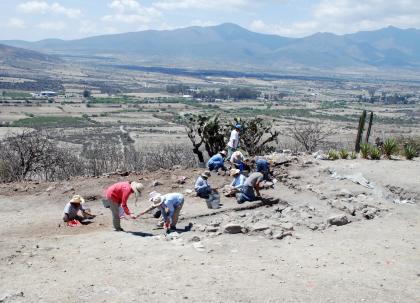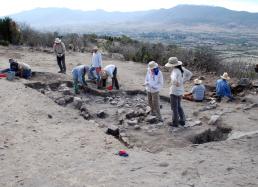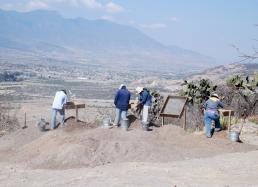2: Homage to My Archaeological Forebears
One of the truly wonderful aspects of having worked much of my professional archaeological career in the Valley of Oaxaca is that I've had the opportunity to build on the findings and accomplishments of so many great archaeologists and scholars. My first experiences in the region came as a member of the crew on the Valley of Oaxaca Settlement Pattern Project under the direction of Richard Blanton and Stephen Kowalewski (two of my graduate school professors) in 1977 and 1980.
Under their direction, not only did I learn the ins and outs of systematic regional archaeological survey—a methodological skill that many years later got Linda and me to Shandong, China—but by walking across the valley for the better part of 16 months, I was able to see the diversity of sites in this area. This included large ones with still-massive earthen platforms and many smaller scatters of pottery (the present surface remains of small hamlets and villages).
These sites include early sedentary settlements that are roughly 3,000 years old and others that were occupied right before the Spanish Conquest. I also saw first hand the vegetation and topographic diversity of this large valley ringed by mountains: the drier areas, such as where we are situated now, as well as wetter parts, which is where I spent more of my time in those early years.
But, even before I actually had the chance to study archaeology in Oaxaca, it was an area whose long-term history intrigued me through the wonderful undergraduate class lectures of Kent Flannery, to which I was fortunate to be exposed at the University of Michigan. Flannery excavated in the Valley of Oaxaca for decades, discovering, among many other things, the remains of what still is the earliest maize (corn) in the Americas. The find was made in a cave that's in the terrain of Mitla, the village where we're now based.
It was through Kent Flannery and his wife and colleague, Joyce Marcus, that I met the great Mexican archaeologist, Ignacio Bernal. I was still a graduate student at the time, fresh from my first long survey in Oaxaca, and I was able to discuss some of what we found with Bernal, who had actually conducted the first reconnaissance in the region while looking for sites. Our later, more systematic work, naturally had recovered many new archaeological settlements, but the majority of the largest ones already were known to Bernal.
I recall Bernal, a stately man, who conducted a good deal of Mexican diplomatic work, as well as being an incredible archaeological scholar. Because this is the 100th anniversary of his birth, and to honor this centenary, the Santo Domingo Museum (of INAH) in Oaxaca has staged a wonderful recollection of his life and work. I was invited to its opening months ago when back in Chicago, but I had to decline because I had already committed to give a paper at a meeting session held around the same week in honor of another of my career mentors, Dr. Melvin Ember, who recently passed away.
Nevertheless, I was determined to get to the Bernal exhibit early in our field season before things got too busy. The exhibition was an outstanding homage, well worth the trip. It featured key elements of the scholar’s life and works, including his pioneering investigations at Monte Albán with Alfonso Caso, as well as Bernal’s own excavations at Mitla and at the nearby site of Yagul.
When in the field, not a day goes by without my thinking about the foundational contributions of Caso, Bernal, Flannery, Blanton, Kowalewski, Marcus, and even The Field Museum’s first Anthropology curator, William Henry Holmes, who mapped the site of Mitla and provided one of the first perspectives on the Mitla Fortress at the end of the 1800s. Without the more than a century of accomplishments by these scholars, whatever findings we make would have little context and much less meaning.
Speaking of the Fortress, our initial results reprised some of what we discovered last year. Right from the start, we encountered domestic architecture close to the modern ground surface (see above photo.) As is typical for this region, we unearthed a series of rooms around an open patio. Although the uppermost residence seemed to date to around the Classic - Postclassic transition (ca. A.D. 800 - 1000), the condition of this upper complex was severely impacted by 20th-century farming and ant activities in parts of the terrace (see Photo #1 below.)
A series of burials (likely from later in the Postclassic period) also were placed intrusively into the foundations of the domestic architecture. Nevertheless, these burials (some of the last indications of prehispanic activities on this terrace) don't appear to be as late in time as the intrusive burials that were found in 2009.
Terrace 56, which we excavated last year, includes a huge boulder that likely served as a lookout in the Late Postclassic era when the great walls (depicted by Holmes and others before him) ringed the apex of this site. Not surprisingly, that terrace seems to have had more late, post-residential use than Terrace 57, which we're presently investigating.
Word of the Day: hormiga, which means “ant.” I never realized before excavating this terrace, how much damage these insects and their cousins can do to an archaeological site.




